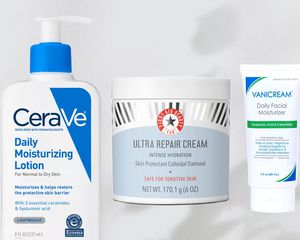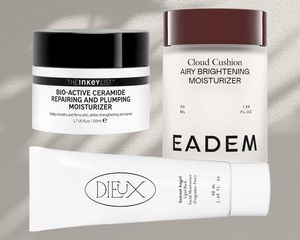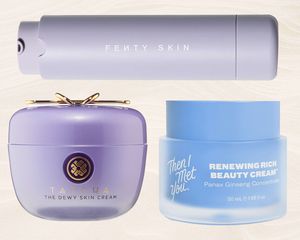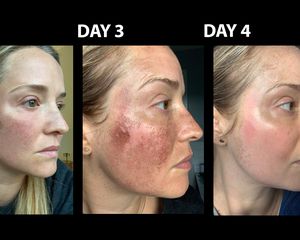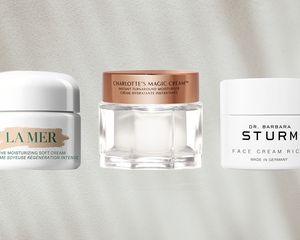:max_bytes(150000):strip_icc()/GettyImages-1353365552-cac311bd20fa4de8bef8c55d80c69bf6.jpg)
masa44 / Getty Images
Petrolatum—better known as petroleum jelly—has been a staple in homes for over a century thanks to its myriad of uses. For years, it had been a dry skin savior, providing instant relief to chapped lips and cracked eczema patches. While nothing quite beats the feeling of smoothing a thick petroleum-based balm onto rough skin, is it actually safe to use? Concerns have arisen regarding its manufacturing process, which includes polycyclic aromatic hydrocarbons (PAHs) that have potentially been linked to cancer.
To separate fact from fiction, we chatted with board-certified dermatologists Lily Talakoub, MD, FAAD, and Flora Kim, MD, FAAD, as well as cosmetic chemist Warren Wallo, MS, and dug deep to learn about the origins of petroleum jelly, its intended uses, and whether or not it's okay to keep slathering it on your body from head to toe.
Meet the Expert
- Lily Talakoub, MD, FAAD, is a board-certified dermatologist based in the Washington, D.C. metro.
- Flora Kim, MD, FAAD, is a board-certified dermatologist based in Highland Park, Texas.
- Warren Wallo, MS, is a retired cosmetic chemist and the former director of Scientific Affairs for Johnson & Johnson.
What Is Petroleum Jelly?
Petroleum jelly is a mixture of natural mineral oils and waxes formed into a partially solid, gel-like substance. Kim refers to Vaseline as "the quintessential petroleum jelly," and we agree. Those mega-sized tubs with blue lids full of a semi-solid substance are what most of us think of when we hear the phrase "petroleum jelly," although the ingredient can be found in countless moisturizers, lip balms, lotions, and even some cosmetics.
Petroleum Jelly
Type of Ingredient: Occlusive
Main Benefits: Seals in moisture, soothes cuts and abrasions, and accelerates the healing process.
Who Should Use It: In general, it's safe for all ages and skin types and is especially beneficial for those with minor wounds and dry, sensitive skin.
How Often Can You Use It: Petroleum jelly is safe to use daily.
Works Well With: Moisturizers
Don't Use With: Very oily, acne-prone skin.
Is Petroleum Jelly Safe?
"Petroleum jelly is one of the safest products for the skin," Talakoub tells us." It is safe on all skin types and has very little allergenic or irritant potential. It holds moisture in the skin and can help heal wounds."
In more recent years, there has been controversy surrounding petroleum jelly. Trying to keep up with the conflicting reports is enough to make a casual skincare user's head spin: Some sources claim that it does not actually heal cuts and wounds and could actually trap bacteria in the skin, while others sing its praises. There are two chief concerns consumers have regarding petroleum jelly:
- Lipid pneumonia: Lipid pneumonia is an infection caused by the inhalation of fats. It occurs when petroleum jelly is used around and inside the nose. According to dermatologists, you will not develop lipid pneumonia through occasional use. With petroleum jelly (and any beauty product, for that matter), make sure to use only as directed. Misuse of any product could lead to undesirable results. Vaseline's representative notes, "Lipid pneumonia is not a known side-effect of using Vaseline in the directed way. Vaseline Jelly is intended for external use only and is safe when used as directed on the packaging." In short, you should be completely fine as long as you don't eat the stuff.
- PAHs: Another concern that has flooded the Internet—with numerous pro and con articles and inflammatory headlines—surrounds those PAHs, known contaminants in unrefined petrolatum. Most commercial petroleum jelly products are made from pure, refined petroleum jelly, and many health professionals, like Andrew Weil, MD, have stated that there is no link between petroleum jelly and cancer. Per Vaseline's representative, "Vaseline Jelly meets U.S. and EU Pharmacopoeia standards on purity. It is triple-purified to remove carcinogenic material—meaning it does not pose a risk of causing cancer. It’s the only petroleum jelly with the unique triple-purification seal."
A representative from Vaseline also assured us that their products are safe to use and can help during the wound-healing process. The brand's research and development team confirms, "For minor scrapes and burns, it has been proven that Vaseline is efficacious for protecting the skin and locking in skin’s natural moisturizers to allow the skin to repair." An independent study also confirms that white petrolatum is an effective tool in wound care, as it helps to prevent scabbing.
The Benefits
- Accelerates wound healing: Petroleum jelly forms a barrier over the skin that protects wounds and accelerates healing.
- Prevents moisture loss: While petroleum jelly itself doesn't hydrate the skin, it does help seal in existing moisture, meaning that it pairs well with lotions and creams.
- Minimizes scabs and scars: Applying this ingredient to small cuts, scrapes, and burns can prevent scabs and scars from forming.
- Acts as a salve on split ends: Due to its moisturizing qualities, petroleum jelly can also be used on split ends of hair, to aid with dryness.
- Treat rashes and eczema: The American Academy of Dermatology recommends petroleum jelly to soothe ailments such as diaper rash in children, eczema, and extremely dry skin.
How to Use Petroleum Jelly
Petroleum jelly is the ultimate multi-use product. It's great for sensitive skin, says Kim, because it doesn't require many "additives/chemicals/potential irritants to formulate." This means that pure petroleum jelly is very simple and typically lacks things like fragrance and essential oils that can cause redness and breakouts in some. Petroleum jelly can be applied directly to the skin or incorporated as an occlusive ingredient in moisturizers, lotions, and other hydrating products.
"Petroleum jelly is often how ‘ointments’ are formulated, and ‘ointments’ are used as effective delivery systems of active ingredients for various conditions," Kim explains. She cautions against using plain petroleum jelly on open or infected wounds. But that doesn't mean you need to avoid the ingredient when you're injured: "For open wounds, you should be applying an antibiotic active ingredient that is delivered via the vehicle of an ointment, but not just petroleum jelly alone." Look for an ointment like Neosporin's 24 Hour Infection Protection Antibiotic Ointment that includes petroleum jelly alongside antibiotic ingredients rather than slathering on raw Vaseline.
How Often Can It Be Used?
There's no real limit to how often you can apply petroleum jelly; it can be used as needed or daily, with some notable exceptions. For example, Kim suggests skipping Vaseline if you're super oily or acne-prone, as it can be pore-clogging.
Can You Use Petroleum Jelly on Your Lips?
While it is safe to use petroleum jelly on your lips, it may not be the most effective option. If apply a product such as Vaseline before your lips are dry and chapped, you may be able to prevent dryness according to our experts. However, because petroleum jelly is an occlusive rather than a moisture-attracting humectant, it isn't the most effective at restoring moisture once it's been lost.
Refined Petroleum Jelly vs. Unrefined Petroleum Jelly
Refined petroleum jelly has been manufactured for safe use by consumers; unrefined petroleum jelly has not.
A lot of the debate about the safety of petroleum jelly use can be summed up by understanding the differences between refined and unrefined petroleum jelly. USP-grade petroleum jelly (which is the purest grade of petroleum and obeys the purity and consistency test standards set by the United States Pharmacopeia) is not the same as the unrefined petrolatum material, which is said to be carcinogenic. Petrolatum in drugs, food, and food packaging must meet FDA impurity restrictions. White petroleum jelly is a refined, purified extract of heavy waxes and paraffinic oils, and USP white petroleum jelly has passed the safety standards of the FDA for use in food and cosmetics.
The problem is that not all manufacturers use refined petrolatum or low-grade refinement processing, and there is the potential for PAHs. Consumers should look for USP white petroleum jelly (known as BP in Britain and Ph. Eur in Europe)—which indicates the grade, where it was refined, and that it meets specific purity standards—and go with trusted brands like Vaseline and Aquaphor. The Environmental Working Group (EWG) has given Vaseline Petroleum Jelly a 1 rating, meaning that the organization considers it a low hazard.
The Final Takeaway
Wallo explains that the skin needs moisture to repair itself and considers petroleum jelly safe for cosmetic use. However, he notes that it's an individual choice that consumers can make with the help of their physician and trusted reference sources. (In other words, you might need to do some research.) "There's no reason to use it if you're uncomfortable," he says.
It hasn't been definitively proven that petroleum-based products are carcinogenic in humans. However, if you want to find alternatives to petrolatum in your skincare products, review the ingredients listed.
